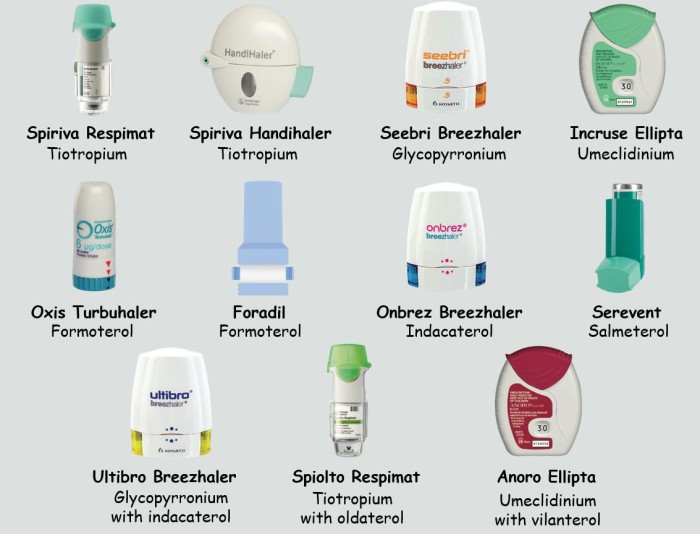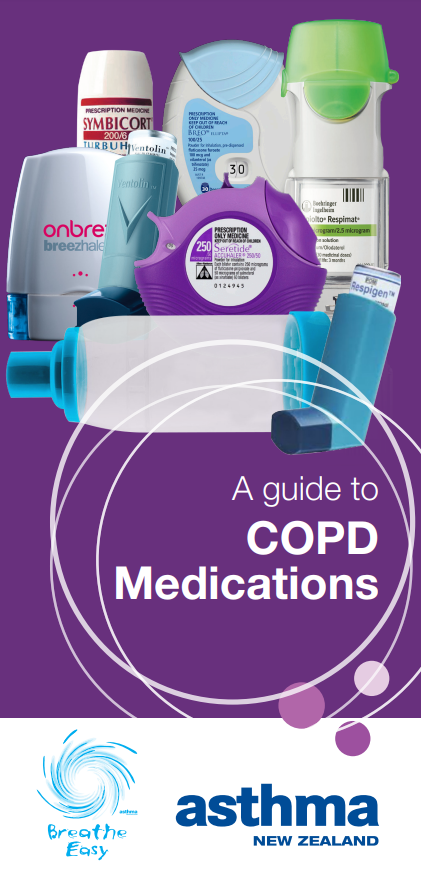COPD medicines
Medicines for chronic obstructive pulmonary disease (COPD)
Key points about COPD medicines
- There are many different types of medicines for COPD (chronic obstructive pulmonary disease).
- They can help to make breathing easier and delay the worsening of your symptoms.
- Some of the medicines used for COPD are also used for asthma.
- Depending on how bad your COPD symptoms are, you may have to take more than 1 medicine.

There's no cure for COPD, but there are many things you can do to slow its progress, improve your symptoms and breathe more easily. These include:
- treating flare-ups early
- regular physical exercise to make you breathe more easily and clear your airways
- quitting smoking if you are smoking
- being up-to-date with your vaccinations
- using your inhaler medicines, as prescribed.
Learn more about COPD.
Inhalers
Inhalers deliver the medicine directly into your lungs as you breathe in. There are a variety of different types of inhalers for COPD. To get the most benefit from your inhaler, it’s important to use them correctly. Ask your healthcare provider to show you how
- Some inhalers have a single medicine, while others may have a combination of medicines in the inhaler.
- Depending on how bad your COPD symptoms are, you may have to use more than 1 inhaler.
- Quick relief inhalers are used to ease breathlessness and their effect only lasts for a few hours. Read more about quick relievers.
- Maintenance inhalers are used every day, whether or not you have symptoms, to make breathing easier over the long term and to prevent flare-ups (your symptoms suddenly getting worse). Read more about maintenance inhalers.
- It's important to have a COPD action plan(external link) to advise you on how to manage your condition day-to-day, when and how to take your medicines and what to do when your symptoms get worse.
- Reliever inhalers work quickly to improve symptoms of breathlessness. They make breathing easier by relaxing and widening your airways.
- They usually start working within minutes and their effect lasts for a few hours. They don’t last long enough to provide 24-hour relief.
- They are also called rescue inhalers or short-acting bronchodilators. For most people this will be salbutamol (see below)
- A single type of quick reliever may be used, but you may be given a combination of them.
- Aerosol inhalers, also called puffers or metered dose inhalers (MDIs), should always be used with a spacer to be most effective. Read more about spacers below.
- If you have COPD and asthma, the combination reliever/preventer medicines (2-in-1) may be used as a reliever.
Examples of quick-relievers (also called rescue inhalers)
- Salbutamol (SalAir®, Ventolin®) metered dose inhaler (MDI)
- Ipratropium (Atrovent®) MDI
- Salbutamol + ipratropium (Duolin®) MDI
- Terbutaline (Bricanyl®) dry powder inhaler.
The use of reliever medicine will be different for different people
- Mild symptoms: If you have mild symptoms you may use a reliever inhaler just when you need it for breathlessness.
- Before exercise: It can also be helpful to use your reliever medicine before you exercise to open up your airways and prevent breathing problems.
- Moderate to severe symptoms: If you have more severe COPD you may have to use a reliever inhaler regularly, up to 4 times a day.
Note: If you find your breathlessness is getting worse, and you need your reliever more often than 4 times a day, talk to your healthcare provider. They will reassess your medicines and may suggest a different reliever or a maintenance inhaler. Read more about maintenance inhalers below.
Many quick relievers that are aerosol or metered dose inhalers (MDI) should be used with a spacer so ask your healthcare provider or pharmacist for one. Read more about spacers.
Tip: Always carry your quick-relief medicine with you.

Image credit: Healthify He Puna Waiora
- Maintenance inhalers are used regularly to control your symptoms and prevent flare-ups.
- Maintenance inhalers include long-acting bronchodilators OR a combination of a steroid inhaler with 1 or 2 long-acting bronchodilators.
- Maintenance inhalers relax the muscles of your airways causing them to open. Some of these medicines may also decrease the amount of mucus made in the airways of your lungs.
- Steroid inhalers reduce inflammation in your airways but only if they're used regularly.
- Most maintenance inhalers take a little longer than relievers to start working but their effects last much longer. This means you only need to use them once or twice a day.
Tip: Maintenance inhalers must be used regularly every day, not just when you're breathless.
Long-acting bronchodilator inhalers (without a steroids)
- Tiotropium (Spiriva®, Spiriva Respimat®)
- Glycopyrronium (Seebri®)
- Umeclidinium (Incruse®)
- Formoterol (Oxis®, Foradil®)
- Indacaterol (Onbrez®)
- Salmeterol (Serevent®)
- Glycopyrronium + indacterol (Ultibro®)
- Olodaterol + tiotropium (Spiolto Respimat®)
- Umeclidinium + vilanterol (Anoro®)

Inhalers with steroids
These inhalers are a combination of a steroid plus a long-acting bronchodilator in a single inhaler. They help to reduce the number of flare-ups by reducing inflammation that causes swelling and mucus production in your airways. These inhalers are usually prescribed if you have:
- moderate to severe COPD and have had 2 or more flare-ups over the previous year that required you to take prednisone (steroid) tablets
- both asthma and COPD
- a blood test showing white blood cells (eosinophils) of more than 0.3 x 109/L.
Examples of long-acting bronchodilator inhalers with steroids
2-in-1 inhalers
- Fluticasone and salmeterol (Seretide®)
- Fluticasone and vilanterol (Breo Ellipta®)
- Budesonide and formoterol (Symbicort®, Vannair®, DuoResp Spiromax®)
3-in-1 inhalers
- Trelegy Ellipta®
- Breztri Aerosphere®
3-in-1 inhalers have a combination of a steroid together with 2 long-acting bronchodilators, in the same inhaler. Using a 3-in-1 inhaler is convenient because you will need to use fewer inhalers.
Tip: After using inhalers with steroids, it's important to rinse your mouth to avoid getting thrush, or experiencing voice changes.
A COPD flare-up is when your COPD symptoms become suddenly worse and are severe. A flare-up is also called an exacerbation.
- A flare-up might be triggered by an infection or there may be no immediately apparent reason for it.
- Use your COPD action plan to help you manage a flare-up. A COPD action plan is a written plan that provides you with instructions on how to manage your COPD each day and also how to manage worsening symptoms (exacerbations).
- Medicines include steroid tablets and antibiotics. Read more about what a COPD flare-up is and how to treat it.
- If you have frequent flare-ups, a review by a specialist service may be recommended. Some people may need longer term treatment with antibiotics or cough medicines (expectorants). Speak to your healthcare provider about this.
Most COPD medicines are available as inhalers, which come in different shapes and sizes. They include:
- metered dose inhalers (MDIs or 'puffers' pressurised aerosol inhalers) which in most cases should be used with a spacer – ask your healthcare provider.
- Respimat® (mist inhaler)
- Turbuhaler® (dry powder inhaler)
- Ellipta® (dry powder inhaler)
- Breezhaler® (dry powder from a capsule inhaler).
You can decide on the inhaler that suits you best by talking with your prescriber or asthma educator. You may want to try a range of inhalers before choosing the one you're most comfortable with.
To get the most benefit from your inhaler, you need to use the correct technique and take it at the right time. Your doctor, nurse or pharmacist should check your technique with you from time to time. Read more about inhalers and things to consider when choosing an inhaler.
A spacer is a clear plastic tube with a mouthpiece or mask at one end and a hole for your inhaler at the other. A spacer is attached to the end of your inhaler to make it easier to use. It also makes the medicine in the inhaler more effective, because more of it can get into your lungs.

Image credit: Healthify He Puna Waiora
Advantages of using a spacer
A spacer is a chamber that holds the medication before you inhale, giving you a more controlled, deeper inhalation. This can be especially helpful if you are short of breath.
- It makes it easier to use your MDI: Many people are unable to use their MDI properly because you need good coordination to press the inhaler and inhale at the same time. The spacer reduces the need for perfect timing. A spacer allows you to press the inhaler and then inhale at a steady pace, making it easier to use.
- It gets more medicine to your lungs: Compared to using your MDI without a spacer, using a spacer delivers much more medicine (up to twice as much) to the lungs, where it’s needed (with less medicine ending up in your mouth and throat).
- It reduces your risk of side effects: When less medicine gets left in your mouth and throat, this reduces the side effects of hoarseness or voice changes and thrush in your mouth from the medicine.
Studies have shown that spacers can work just as well as nebulisers, even for flare-ups. A spacer is smaller, and more convenient than a nebuliser.
Read more about spacers.
A nebuliser is a machine that turns liquid medicine into a fine mist that you can easily breathe into your lungs. The machine has a mouthpiece or face mask that you use to breathe in the medicine for 3 to 10 minutes.
- Nebulisers may be used to help you take your reliever medicine when your COPD is so bad that you can’t use your inhaler and spacers as you usually do.
- They may be used during a flare-up or exacerbation of your COPD.
- For most people with COPD, aerosol inhalers used with a spacer are just as effective and they carry less risk of spreading infections and viruses.
- Nebulisers are now used much less than before.
- Nebulisers can be purchased from some pharmacies but the medications will need to be prescribed by your healthcare provider. Read more about nebulisers.
Many people think oxygen is given to treat shortness of breath, but this is not the case. Being short of breath, or feeling like you can’t get enough air into your lungs, doesn't necessarily mean you're short of oxygen. If your healthcare provider thinks your oxygen levels are low they will check this with a device that clips onto your finger, called a pulse oximeter.
- Low oxygen levels for short periods of time and while you're still feeling reasonably okay are not necessarily a concern. This is similar to being at high altitude.
- However, if your body has low oxygen levels for long periods it can put a strain on your heart and then lead to heart problems as well.
If there's concern that your oxygen levels are low for a lot of the time, your healthcare provider will order a special blood test (arterial blood gas test). You may need to be seen by a respiratory specialist.
- Oxygen is given to prevent strain on your heart, and your specialist will decide if you need it.
- You must have stopped smoking for several months to qualify for home oxygen.
- If you need oxygen, it should be used for at least 15 to 16 hours in each 24 hours, but not necessarily all the time – periods off oxygen during the day are not harmful but it should be used when you're sleeping.
- The oxygen machine is called an oxygen concentrator. Oxygen concentrators create some noise (similar to a dishwashing machine in your kitchen).
- You will be given small tubes that deliver oxygen to your lungs via your nose. The connecting tubes can be several metres long, so you can move around parts of your home while connected.
- You will need a reliable power supply and a plan for what to do if the power is disconnected (such as a letter for your power company).
- Portable oxygen tanks or cylinders are also available if you meet certain criteria and having the concentrator machine is not enough.
You must never smoke while you're taking oxygen, because of the high risk of fire.
Read more about home oxygen therapy.
Manage your COPD(external link) Asthma and Respiratory Foundation, NZ
Brochures
A guide to COPD medications(external link) Asthma NZ
5 questions to ask about your medications(external link) Health Quality and Safety Commission, NZ, 2019 English(external link), te reo Māori(external link)
Medicines and side effects [PDF, 91 KB] Healthify He Puna Waiora, NZ, 2024
References
- NZ COPD guidelines 2021(external link) Asthma and Respiratory Foundation, NZ, 2021
- An update on the pharmacological management of stable COPD(external link) BPAC, NZ, 2020
- COPD(external link) NZ Formulary
- Young R. Simplifying COPD treatment(external link) Research Review, NZ, 2023
- McDonald CF, Serginson J, AlShareef S, et al. Thoracic Society of Australia and New Zealand clinical practice guideline on adult home oxygen therapy(external link) Respirology 2024;29(9):765–784
- Yang IA, George J, McDonald CF, et al. The COPD-X plan – Australian and New Zealand Guidelines for the management of chronic obstructive pulmonary disease 2024(external link) Version 2.76, September 2024
Brochures

Medicines and side effects
Healthify He Puna Waiora, NZ, 2024

Health Quality and Safety Commission, NZ, 2019
English(external link)Te reo Māori(external link)
Credits: Sandra Ponen, Pharmacist, Healthify He Puna Waiora. Healthify is brought to you by Health Navigator Charitable Trust.
Reviewed by: Dr Roland Meyer, Specialist Physician, Respiratory and General Medicine; Angela Lambie, Pharmacist, Auckland
Last reviewed:






